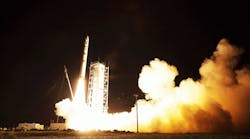WASHINGTON -- NASA launched its latest orbiter to Mars Monday on the hunt for clues about why the Red Planet lost much of its atmosphere.
The launch of Mars Atmosphere and Volatile EvolutioN (MAVEN), took place at Cape Canaveral, Florida. The eight-foot cube-shaped spacecraft weighs 5,410 pounds and was launched aboard an Atlas V 401 rocket.
Researchers have described the mission as a search for a missing piece to the puzzle of what happened on Mars, perhaps billions of years ago, to transform Earth's neighbor from a water-bearing planet that might have been favorable for life to a dry, barren desert with hardly any atmosphere.
"MAVEN is the first spacecraft devoted to exploring and understanding the Martian upper atmosphere," the U.S. space agency said.
"The spacecraft will investigate how the loss of Mars' atmosphere to space determined the history of water on the surface."
NASA has sent a series of rovers to explore the surface of the Red Planet, including its latest, Curiosity, which arrived last year.
The deep space orbiter launched earlier this month by India seeks to find traces of methane from Mars and may arrive two days later than the U.S. spacecraft. The science goals of the two do not overlap much. The Indian probe will be searching for methane which could prove the existence of some ancient life form, while the U.S. probe seeks answers about the planet's climate change.
The entire MAVEN mission cost $671 million.
The journey to Mars will take 10 months in total, with arrival set for September 2014 and the science mission of the solar-wing paneled orbiter set to begin in November 2014.
Much of its year-long mission will be spent circling the planet at a distance of 3,800 miles above the surface, but it will execute five deep dips to a height of just 78 miles to get readings of the atmosphere at various levels.
Scientists hope its findings will help pave the way for a future visit by humans to the Red Planet, perhaps as early as the 2030, NASA has said.
Copyright Agence France-Presse, 2013



